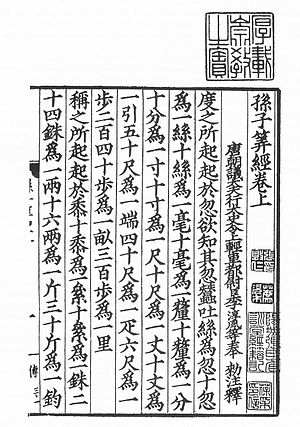Sunzi Suanjing

The Mathematical Classic of Sun Zi (Sunzi Suanjing, 孙子算经) was a mathematical treatise written during the 5th century, and was listed as one of The Ten Computational Canons in Tang Dynasty. The identity of the author Sunzi is still unknown, and not to be confused with the author of The Art of War. From the textual evidence in the book, some scholars concluded that the work was completed during the Southern and Northern Dynasties, for instance, in problem 33, of vol 3, it is written, "Luoyang is 900 li away from Chang'an", as Chang'an first showed up in Han Dynasty, this work cannot have been written before the 3rd century. Additionally, in problem 3 of vol 3, Sun Zi writes: "We have a board game, 19 rows and 19 columns square, question, how many stones are there?". Since Go made its first appearance in the mid 3rd century, the work was most probably written during the Wei and Jin Dynasties.[1]
Content




The book is divided into three chapters:
Chapter 1: Detailed discussion on measurement units of length, weight and capacity, and the rules of counting rods. Although counting rods were in use in the Spring and Autumn Period and many ancient books on mathematics such as Book on Numbers and Computation, The Nine Chapters on the Mathematical Art, but no detail account of the rules were given. For the first time, The Mathematical Classic of Sun Zi provided a detail description of the rules of counting rods: "one must know the position of the counting rods, the units are vertical, the tens horizontal, the hundreds stand the thousands prostrate".[2] Followed by the detailed layout and rules for manipulation of the counting rods in addition, subtraction, multiplication, and division with ample examples.
Chapter 2 deals with operational rules for fractions with rod numerals: the reduction, addition, subtraction, and division of fractions, followed by mechanical algorithm for the Extraction of Square root.[3]
Chapter 3 contains the earliest example of Chinese remainder theorem.
Translation
There is a full translation of The Mathematical Classic of Sun Zi, by Lam Lay Yong and Ang Tian Se in Tracing the Conception of Arithmetic and Algebra in Ancient China FLEETING FOOTSTEPS, Translation of Sun zi Suanjing p149-182.
References
- ^ Lam Lay Yong and An Tian Se, Fleeting Footsteps p4, World Scientific, ISBN 981-02-3696-4
- ^ Lam Lay Yong and An Tian Se, Fleeting Footsteps p55, World Scientific, ISBN 981-02-3696-4
- ^ Lam Lay Yong and An Tian Se, Fleeting Footsteps p65, World Scientific, ISBN 981-02-3696-4
